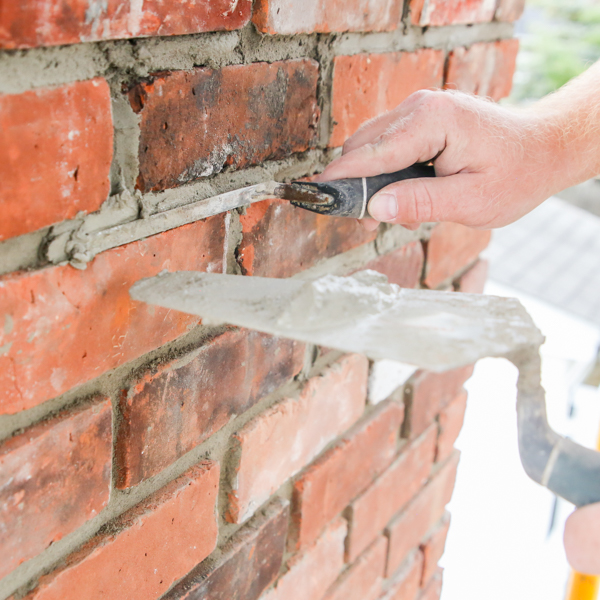Opening the Keys of Sustainable Masonry Building Practices for Eco-Friendly Structures
In the realm of modern-day building and construction, the search of lasting practices has actually come to be critical. Among the myriad techniques to environment-friendly structure, sustainable masonry building stands out as a tried and true and sturdy approach that holds a riches of untapped potential. From the option of materials to cutting-edge building and construction techniques, the keys to achieving sustainability within stonework building and construction are multifaceted and interesting. By checking out the benefits, products, techniques, and future patterns of sustainable stonework, a deeper understanding of exactly how these practices can shape the future of environmentally friendly structures emerges.
Benefits of Lasting Masonry Construction
Welcoming lasting stonework construction methods not only decreases ecological effect however likewise offers long-lasting economic advantages to home builders and neighborhoods. By making use of products like recycled bricks, obstructs, and rocks, builders can considerably decrease the carbon footprint of their tasks while advertising source performance. In addition, sustainable masonry construction techniques, such as correct insulation and thermal mass properties, can enhance power effectiveness within structures, leading to decreased functional costs over time.
Additionally, the sturdiness and durability of masonry structures add to lasting financial advantages. Buildings created utilizing sustainable masonry techniques typically require much less repair and maintenance, equating to cost financial savings for builders and homeowner. The longevity of masonry products additionally makes sure that frameworks remain secure and safe and secure, minimizing the need for constant renovations or replacements.
Eco-Friendly Masonry Products
Using eco-friendly masonry materials is a crucial step towards boosting the sustainability of construction practices and lessening ecological influence while making the most of long-lasting economic benefits. Lasting masonry products are sourced, created, and made use of in a fashion that lowers general environmental influence. Materials such as recycled blocks, recovered rock, and sustainable cinder block are becoming significantly preferred options for eco-conscious builders. Recycled bricks, for instance, not only draw away waste from garbage dumps yet likewise require less energy to create contrasted to brand-new blocks. Recovered stone offers an one-of-a-kind visual charm while minimizing the need for brand-new quarrying. Lasting concrete blocks include recycled accumulations and might include enhanced insulation properties, adding to power performance in structures.
Furthermore, natural materials like adobe, rammed planet, and straw bundles provide superb thermal mass buildings, minimizing the requirement for home heating and cooling power. These materials are usually locally offered, promoting local economic climates and decreasing transportation-related carbon emissions. By picking environment-friendly masonry materials, building and construction projects can dramatically reduce their ecological impact and add to the development of healthier, a lot more lasting developed atmospheres.
Energy-Efficient Stonework Techniques
Power effectiveness plays a crucial function in improving the sustainability of masonry building and construction methods. By implementing energy-efficient stonework techniques, building contractors can significantly minimize the total power intake of a structure, causing lower functional prices and a smaller environmental impact. One essential energy-efficient masonry technique is the use of thermal mass, which involves including dense products like concrete or block right into the building's structure to take in and store warm. This ford used helps regulate indoor temperatures, lowering the requirement for mechanical heating and cooling systems.

Developments in Lasting Masonry
Recent improvements in lasting stonework methods have produced ingenious techniques that are improving the building industry. One such technology is the development of self-healing concrete, which makes use of microorganisms embedded within the concrete to heal cracks autonomously. This breakthrough not only decreases maintenance costs yet additionally enhances the durability of stonework frameworks, adding to their sustainability.
An additional noteworthy development is the use of recycled aggregates in stonework construction - masonry contractor. By integrating materials such as crushed ceramic waste or recycled glass into concrete blends, home builders can reduce the environmental effect of building and construction projects while maintaining structural honesty. This practice not just diverts waste from garbage dumps however also conserves natural deposits, making it a crucial advancement in lasting masonry building and construction
Moreover, the integration of digital layout devices, such as Structure Info Modeling (BIM), is revolutionizing the way masonry structures are prepared and built. BIM permits for even more specific calculations, decreased product wastage, and enhanced power effectiveness, inevitably causing more lasting structure techniques. These developments jointly indicate an encouraging future for sustainable stonework construction in the era of environment-friendly structures.
Future Trends in Masonry Sustainability
With the cutting-edge strides made in sustainable stonework methods, the future patterns in masonry sustainability are positioned to more revolutionize the building and construction market. visit the site Among the crucial fads forming the future of stonework sustainability is the boosted combination of innovation. Advancements such as Structure Information Modeling (BIM) and online reality simulations are being utilized to enhance stonework building procedures, leading to minimized material waste and enhanced power effectiveness in buildings.
Moreover, the development of unique lasting products is set to play a significant function in enhancing the eco-friendliness of masonry building and construction. masonry contractor. Developments like self-healing concrete, recycled accumulations, and bio-based binders are getting traction for their ability to decrease ecological influence while preserving architectural stability

Final Thought
In final thought, lasting masonry building and construction practices offer numerous advantages for environmentally friendly buildings. masonry contractor. Technologies in lasting stonework are continuously being created to further improve the environmental efficiency of structures.